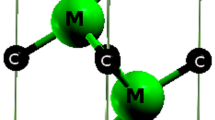Abstract
A separate description of polymorphs and glassy, liquid, and gaseous states makes it possible, using the isobaric-isothermal potential minimization approach, to describe both the phase transformations of an individual substance and its behavior in complex systems, which is required for the representation of metal and salt systems that have melting points lower than the melting points of the pure components. The suggested methods of extrapolation of the thermodynamic functions of an individual substance, performed assuming that of the phase transition heat is constant and that the heat capacity beyond the equilibrium temperature range is equal to the heat capacity of the preceding or subsequent (by temperature) phase state, enable to avoid thermodynamic paradoxes in all cases and reliably describe the composition of complex systems in a wide P,T range of their existence with allowance for the existence of solid phases, melts, and gases in equilibrium.
Similar content being viewed by others
References
L. V. Gurvich, I. V. Veits, V. A. Medvedev, et al., Thermodynamic Properties of Individual Substances, 3rd ed. (Nauka, Moscow, 1978–1982) [in Russian].
M. W. Chase, C. A. Davies, J. R. Downey, et al., JANAF Thermochemical Tables, 3rd ed. (Am. Chem. Soc., Washington, D.C.; Am. Inst. of Phys. for the Nat. Bureau of Standards, New York, 1985).
I. K. Karpov, A. I. Kiselev, and F. A. Letnikov, Computer Simulation of Natural Mineral Formation (Nedra, Moscow, 1976) [in Russian].
I. K. Karpov, Physicochemical Computer Simulation in Geochemistry (Nauka, Novosibirsk, 1981) [in Russian].
R. G. Berman and T. H. Brown, Contrib. Mineral. Petrol. 94, 168 (1986).
J. W. Gibbs, The Collected Works, vol. 1: Thermodynamics (Longman, Green, New York, 1928; Gostekhizdat, Moscow, Leningrad, 1950).
R.A. Robinson and R. H. Stokes, Electrolyte Solutions (Butterworth, London, 1959; Inostrannaya Literatura, Moscow, 1963).
N. M. Bazhin, V. A. Ivanchenko, and V. N. Parmon, Thermodynamics for Chemists, 2nd ed. (Khimiya, KolosS, Moscow, 2004) [in Russian].
I. K. Karpov, K. V. Chudnenko, D. A. Kulik, et al., Geochem. Int. 39, 1108 (2001).
Phase Diagrams of Binary Metal Systems, Ed. by N. P. Lyakishev (Mashinostroenie, Moscow, 1996) [in Russian].
Author information
Authors and Affiliations
Additional information
Original Russian Text © V.A. Bychinskii, A.A. Tupitsyn, K.V. Chudnenko, A.V. Mukhetdinova, S.V. Fomichev, V.A. Krenev, 2013, published in Zhurnal Neorganicheskoi Khimii, 2013, Vol. 58, No. 10, pp. 1336–1342.
Rights and permissions
About this article
Cite this article
Bychinskii, V.A., Tupitsyn, A.A., Chudnenko, K.V. et al. Extrapolation of thermodynamic functions in calculation of phase equilibria by the Gibbs energy minimization method. Russ. J. Inorg. Chem. 58, 1197–1202 (2013). https://doi.org/10.1134/S0036023613100021
Received:
Published:
Issue Date:
DOI: https://doi.org/10.1134/S0036023613100021




